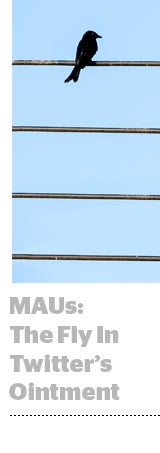 There’s nothing investors want to see more from Twitter than monthly active user (MAU) growth. It’s been the recurring theme every quarter since former CEO Dick Costolo flew the coop in June.
There’s nothing investors want to see more from Twitter than monthly active user (MAU) growth. It’s been the recurring theme every quarter since former CEO Dick Costolo flew the coop in June.
The needle moved minutely this past quarter. Twitter told investors on Tuesday that its monthly active user base increased from 305 million last quarter to 310 million in Q1 2016. That’s a 3% increase. Year over year, Twitter grew by just 8 million users from 302 million in Q1 2015.
(These numbers exclude Twitter’s so-called SMS fast followers, the negligible number of users who access Twitter via text messages. In Q4 2015, Twitter reported 320 million MAUs including SMS fast followers.)
Revenue, however, painted a somewhat rosier picture, reaching $595 million in Q1, a 36% increase YoY. Ad revenue grew 37% to $531 million. Data licensing and other revenue brought up the rear at $64 million, up 34% YoY. Mobile advertising revenue was 88% of total advertising revenue.
Twitter’s healthy ad revenue could be a result of its TellApart acquisition. In Q4, Twitter finally piloted a “dynamic product ad” (DPA) test built on the tech it brought on board from TellApart in August. The test allowed direct-response advertisers to target users with personalized ads based on their browsing behavior.
According to Twitter, marketers in the test saw twice as many clickthrough with dynamic ads as they did with traditional promoted tweets.
“Direct-response advertisers responded well to the new inventory that exists across the Twitter Audience Platform,” said Twitter Chief Operating Officer Adam Bain, noting that this is also the first real example of Twitter bringing the TellApart technology to bear on its owned-and-operated properties.
Similar to Facebook’s Audience Network, Twitter Audience Platform (TAP) allows advertisers to extend their reach off of Twitter’s owned-and-operated (O&O) properties.
“What we need to do next is to bring remarketing budgets onto the platform at scale. To do that, we’re lighting up our API and other third-party partners,” Bain said. “That should work for TAP in a big way and also for Twitter’s O&O, both logged in and logged out, because remarketing budgets can take advantage of the targeting that’s available for logged-out users.”
Unsurprisingly, Twitter was also quite bullish around live video, especially considering its recently announced agreement with the NFL to stream 10 Thursday night football games. Twitter is hopeful the deal will boost engagement with its core user base and attract nonusers to the platform.
In terms of video ad products, Twitter is seeing more advertisers adopt promoted video over traditional promoted tweets. Mainly, that’s due to performance, Bain said. A recent return on advertising spend study over the fall season found that promoted video generated $6 for every dollar spent on Twitter.
That said, brand marketers did not increase their spend on Twitter this quarter, and year-over-year revenue growth from large brand advertisers was “softer than expected,” according to Twitter’s letter to shareholders.
“Overall brand spend didn’t grow as quickly as we might have expected,” Bain admitted to investors on the earnings call. “Video was strong in the quarter [but] offset by the softness of older legacy products.”
Twitter expects video to be its knight in shining armor.
“Video opportunities will grow the budgets we have access to,” Bain said, noting that Twitter is working on rolling out a number of video-related tools in the autumn around reach and frequency planning, demographic targeting and verification to coincide with the start of the NFL season and to bolster its live-streaming strategy.
The competition on the live-streaming scene is fierce, though. Twitter CEO Jack Dorsey bristled ever so slightly in response to a question about Facebook’s recent full-court press into live video.
“We’ve been doing live for 10 years,” he said.
In other news, Twitter’s integrations with DoubleClick Bid Manager (DBM) and Google’s DoubleClick Campaign Manager (DCM) are proceeding apace. Twitter expects to alpha launch the DBM deal, which would allow DoubleClick advertisers to buy Twitter ads through its ads API, in Q3.
On the DCM side, Twitter is expanding its beta test to try and get a better sense of how Twitter ads perform across desktop and mobile.
The initial results point to the reality that cross-device measurement isn’t really there yet. It’s an industrywide issue, said Bain.
“Cross-device measurement is something the industry overall needs to address,” he said. “Ninety percent of our ad impressions are on mobile, so cross-device is really important for us.”













